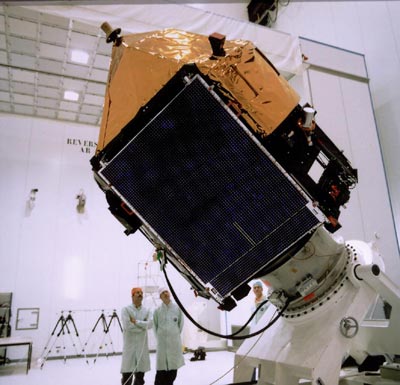Satellite Design - Hipparcos
Satellite Design |
||
 |
The satellite has been described in the literature on several occasions, and a comprehensive description of the satellite, the payload and the data reductions has been given in Volume 2 of The Hipparcos and Tycho Catalogues. The payload was centred around an optical all-reflective Schmidt telescope. A novel feature of the telescope was the 'beam combining' mirror, which brought the light from the two fields of view, separated by about 58 degrees and each of dimension 0.9 x 0.9 degrees, to a common focal surface, and thus achieved both large- and small-field measurements simultaneously. The satellite swept out great circles over the celestial sphere, and the star images from two fields of view were modulated by a highly regular grid of 2688 transparent parallel slits located at the focal surface and covering an area of 2.5 x 2.5 cm². |
|
|
The satellite was designed to spin slowly, completing a full revolution in just over two hours. At the same time, it was controlled so that there was a continuous slow change of direction of the axis of rotation. In this way the telescope was able to scan the complete celestial sphere several times during its planned mission. As the telescope scanned the sky, the starlight was modulated by the slit system, and the modulated light was sampled by an image-dissector-tube detector, at a frequency of 1200 Hz. At any one time, some four or five of the selected (or programme) stars were present in the combined fields of view. The detector had a small sensitive area which covered an area of about 38 arcsec in diameter (projected on the sky). The detector could only follow the path of one star at a time, but, under rapid computer control, could be switched to all the programme stars for short intervals of time during their passage across the field, which took about 20 seconds. The telescope was continually determining the relative (along-scan) positions of the programme stars which appeared first in the preceding field of view and then in the following field of view due to the rotation of the satellite. In this way several comparisons with different stars were made. As the scans also overlapped 'sideways' when the satellite axis of rotation changed on each sweep of the sky, the stars appeared again, but this time compared with other stars. In this way, a dense net of measurements of the relative angular separations of the stars was progressively built up. In addition to the main instrument (designed to measure about one hundred thousand stars down to about 12 mag), the payload included two star mappers (one redundant), whose function was to provide data allowing precise real-time satellite attitude determination (a task performed on board the satellite), and the a posteriori reconstruction of the attitude (a task carried out on the ground). The star mapper data are also used by the Tycho experiment to perform astrometric and two-colour photometric measurements of about one million stars down to about 10-11 mag. (In a later reanalysis data for more than two million objects were extracted from the star mapper data resulting in the Tyhco-2 catalogue.) Each star mapper consisted of a non-periodic modulating grid located at the sides of the primary modulating grid, and two photomultipliers measuring the light transmitted by the whole star mapper grid in two different spectral bands, roughly corresponding to the Johnson B (blue) and V (visual) bands. The spectral separation was achieved through the use of a dichroic beam splitter. Each star mapper consisted of two sets of four slits, each set at different inclinations with respect to the scanning direction, so that the satellite attitude could be derived from the detector signals as the star images moved across the grid. The modulated light signal was converted into photon counts by the two photomultiplier tubes, which were sampled at a frequency of 600 Hz. From the digitised photon counts from the main detector sent to the ground, along with relevant attitude information from the satellite's star mappers and other house-keeping data, the relative phases of the star images present within the combined fields of view were derived. The data processing was carried out on the ground, and led, after a full analysis of the data collected during the mission lifetime, to the final catalogue of star positions, parallaxes and proper motions. |
||
- Removed a total of (6) style text-align:justify;
- Removed a total of (1) style float:left;
- Removed a total of (1) style margin:0;
- Removed a total of (1) border attribute.
- Removed a total of (1) cellpadding attribute.
- Removed a total of (1) cellspacing attribute.








































 Sign in
Sign in
 Science & Technology
Science & Technology